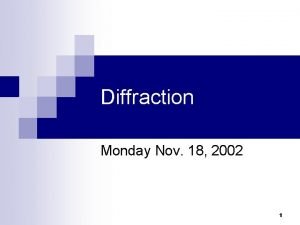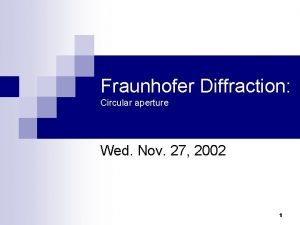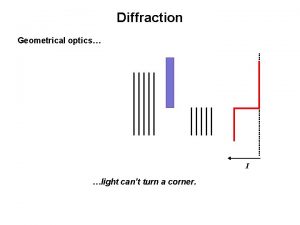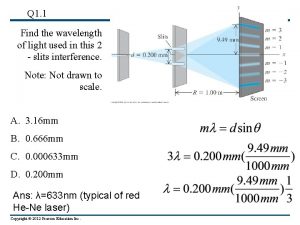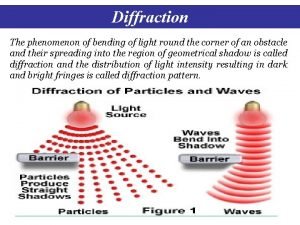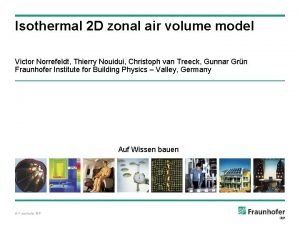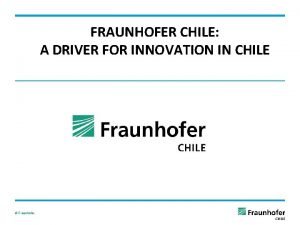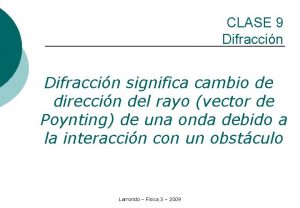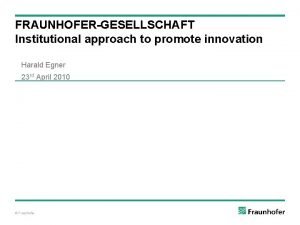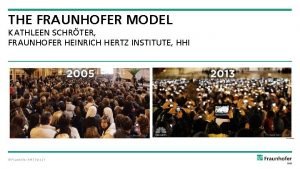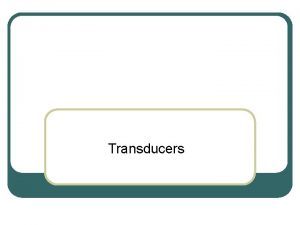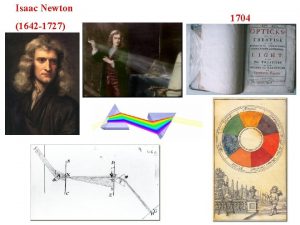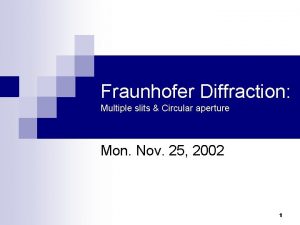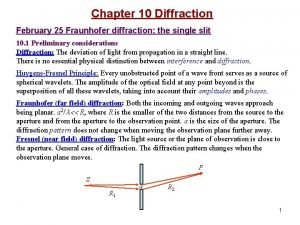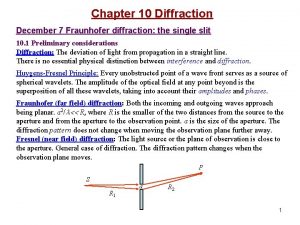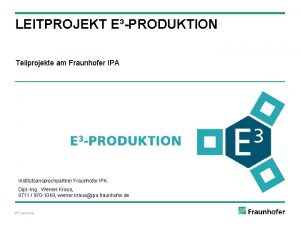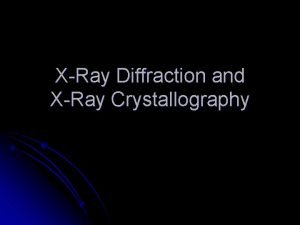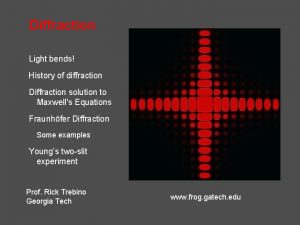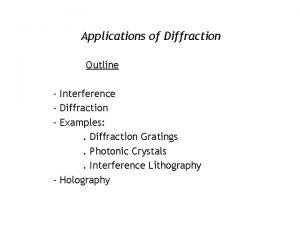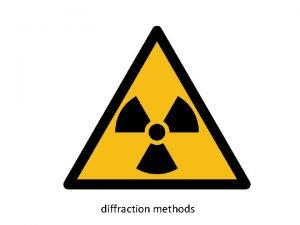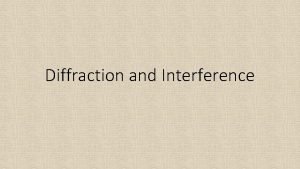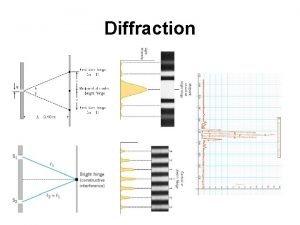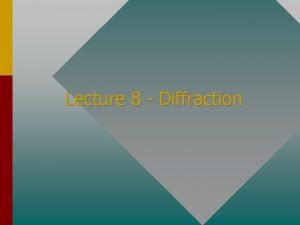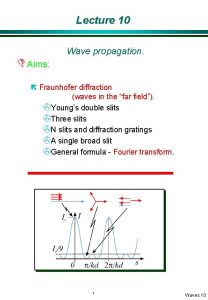Fraunhofer Diffraction Wed Nov 20 2002 1 Kirchoff


















- Slides: 18

Fraunhofer Diffraction Wed. Nov. 20, 2002 1

Kirchoff integral theorem This gives the value of disturbance at P in terms of values on surface enclosing P. It represents the basic equation of scalar diffraction theory 2

Geometry of single slit Have infinite screen with aperture A Let the hemisphere (radius R) and screen with aperture comprise the surface ( ) enclosing P. S Radiation from source, S, arrives at aperture with amplitude r’ ’ P r Since R E=0 on . R Also, E = 0 on side of screen facing V. 3

Fresnel-Kirchoff Formula n Thus E=0 everywhere on surface except the portion that is the aperture. Thus from (6) 4

Fresnel-Kirchoff Formula n n Now assume r, r’ >> ; then k/r >> 1/r 2 Then the second term in (7) drops out and we are left with, Fresnel Kirchoff diffraction formula 5

Obliquity factor Since we usually have ’ = - or n. r’=-1, the obliquity factor F( ) = ½ [1+cos ] n Also in most applications we will also assume that cos 1 ; and F( ) = 1 n For now however, keep F( ) n 6

Huygen’s principle n Amplitude at aperture due to source S is, n Now suppose each element of area d. A gives rise to a spherical wavelet with amplitude d. E = EAd. A n Then at P, n Then equation (6) says that the total disturbance at P is just proportional to the sum of all the wavelets weighted by the obliquity factor F( ) n This is just a mathematical statement of Huygen’s principle. 7

Fraunhofer vs. Fresnel diffraction n In Fraunhofer diffraction, both incident and diffracted waves may be considered to be plane (i. e. both S and P are a large distance away) n If either S or P are close enough that wavefront curvature is not negligible, then we have Fresnel diffraction S P Hecht 10. 2 Hecht 10. 3 8

Fraunhofer vs. Fresnel Diffraction ’ r’ S r h’ d’ h d P 9

Fraunhofer Vs. Fresnel Diffraction Now calculate variation in (r+r’) in going from one side of aperture to the other. Call it 10

Fraunhofer diffraction limit n Now, first term = path difference for plane waves sin ’≈ h’/d’ sin ≈ h/d sin ’ + sin = ( h’/d + h/d ) Second term = measure of curvature of wavefront Fraunhofer Diffraction 11

Fraunhofer diffraction limit n n n If aperture is a square - X The same relation holds in azimuthal plane and 2 ~ measure of the area of the aperture Then we have the Fraunhofer diffraction if, Fraunhofer or far field limit 12

Fraunhofer, Fresnel limits n The near field, or Fresnel, limit is n See 10. 1. 2 of text 13

Fraunhofer diffraction Typical arrangement (or use laser as a source of plane waves) n Plane waves in, plane waves out n S screen f 1 f 2 14

Fraunhofer diffraction 1. 2. Obliquity factor Assume S on axis, so Assume small ( < 30 o), so Assume uniform illumination over aperture r’ >> so 3. is constant over the aperture Dimensions of aperture << r r will not vary much in denominator for calculation of amplitude at any point P consider r = constant in denominator 15

Fraunhofer diffraction n Then the magnitude of the electric field at P is, 16

Single slit Fraunhofer diffraction P y=b dy y r ro r = ro - ysin d. A = L dy where L ( very long slit) 17

Single slit Fraunhofer diffraction Fraunhofer single slit diffraction pattern 18
 Fresnel and fraunhofer diffraction difference
Fresnel and fraunhofer diffraction difference Fraunhofer diffraction pattern circular aperture
Fraunhofer diffraction pattern circular aperture Diffraction by circular aperature
Diffraction by circular aperature Diffraction through single slits derivation
Diffraction through single slits derivation Missing order in diffraction
Missing order in diffraction Fraunhofer
Fraunhofer Fraunhofer
Fraunhofer Fraunhofer mevis
Fraunhofer mevis Fraunhofer
Fraunhofer Fraunhofer moez
Fraunhofer moez Fraunhöfer
Fraunhöfer Harald egner
Harald egner Fraunhofer institute for cell therapy and immunology
Fraunhofer institute for cell therapy and immunology Hertz
Hertz L
L Raggio atomico stronzio
Raggio atomico stronzio Fraunhofer
Fraunhofer Fraunhofer
Fraunhofer Fraunhofer
Fraunhofer
